They grow some marvellous salvias in the Brooklyn Botanic Garden. Late October, and in the autumn sunlight, the gardens were still full of colour. I remember, just as we were leaving, the most spectacular sight – a hugely dramatic salvia with bright blue flowers contrasting with lime green calyces. What I wouldn’t have given for a cutting.
But there’s no need to travel that far to find salvias. We’re lucky to have Dyson’s Nursery at Great Comp, Sevenoaks where William Dyson grows about 250 different varieties. His range of woody summer flowering salvias was extended by James Compton’s discovery in the Sierra Madre, Mexico of a hybrid (S. jamensis) between S. microphylla, the mountain sage, and S. greggii, the autumn sage. These shrubby, woody plants are in the main hardy and have a long flowering period, sometimes right through to November. Easy to grow on well-drained sites and easy to propagate; just take a heel cutting during the summer and pop them into a 50/50 mix of horticultural sand and compost, and off they’ll go.
Salvias are in the genus, Lamiaceae, the mint family, which contains at least nine hundred species with many originating in Central and South America, the Southern states of the USA and Mexico. The majority of salvias are sun loving and many grow in high mountainous regions. The name comes from the Latin ‘Salvus’ meaning, ‘whole, health and safe’ as some of the species salvias have been grown in Apothecaries’ gardens for centuries for their medicinal qualities. I particularly like S. lavandulifolia, the lavender leaved salvia, not only for its leaves and its culinary uses but for the masses of mauve blossom that it throws out in the summer. Here are some of my other favourites:
Salvia greggii ‘Dark Dancer’. Lovely deep fuchsia flowers on wiry stems. Perfect for a dry garden soil but again must be well drained. It’s native to the arid deserts of Mexico.
S. ‘Silas Dyson’ is a pretty gorgeous hardy shrubby salvia. It’ll flower for you from June right through until November. The buds are a rich purple and the flowers are a strong crimson, fading as they mature to red. Another bonus is that the plant is very floriferous.
Salvia microphylla ‘Wild Watermelon’ has grey calyces and wide lipped pink, pink, pink flowers.
Salvia microphylla ‘Icing Sugar’ is a child of the popular but ever so bright ‘Hot Lips’, which grows to about three feet and has pink and purple flowers.
It is easy to become a bit addicted to salvias as their variety is staggering and they have such fascinating flowers which consist of colourful tubes, sometimes soft and downy, with two lips of different lengths. The calyces that they emerge from are often as decorative as the flower, so you get a bonus, as in Salvia atrocyanea which has arching stems and long drooping flowers in a deep blue with bright green calyces and blue tinged bracts. Sounds familiar; maybe this was the mystery Brooklyn plant?
Then there are the drama queens such as the purple Salvia ‘Amistad’, used a lot at Great Dixter. It has large distinctive, corrugated leaves and stems run through with red but it’s the flowers that I love – small and orangey-red growing in sizeable spikes above the leaves. It is not hardy though and has to be lifted and wheeled into shelter for the winter. It’s the same with S. guaranitica ‘Black and Blue’; bright indigo flowers combine with a jet black calyx. Bliss, but lift it in the autumn, once it has flowered. Also, there is S. ‘Phyllis’ Fancy’. It has been described as hardy but I wouldn’t risk it.
And we haven’t even started on the hardy perennial salvias, such a boon in the herbaceous border, and the silvery
S. leucanthas – but they can wait for another time.
- words: Sue Whigham
You may also like
In the Night Garden
Jo Arnell explains how to make the most of your outdoor space once darkness falls Some enchanted evening you may see me outside – mainly searching for slugs in the garden, because the cool hours of night are when they...
Contain your excitement
Jen Stuart-Smith discusses how to get creative with your pots and planters My love affair with plants started with houseplants when I was a child. As my bedroom windowsill overflowed – resulting, occasionally, in waking up with compost under my...
More than just a pretty face
Jen Stuart-Smith explores the multiple uses of some easy-to-grow garden favourites When you grow flowers for their beauty, shape and colour it can be easy to forget all the other qualities they have to offer. Some are edible, others provide...










